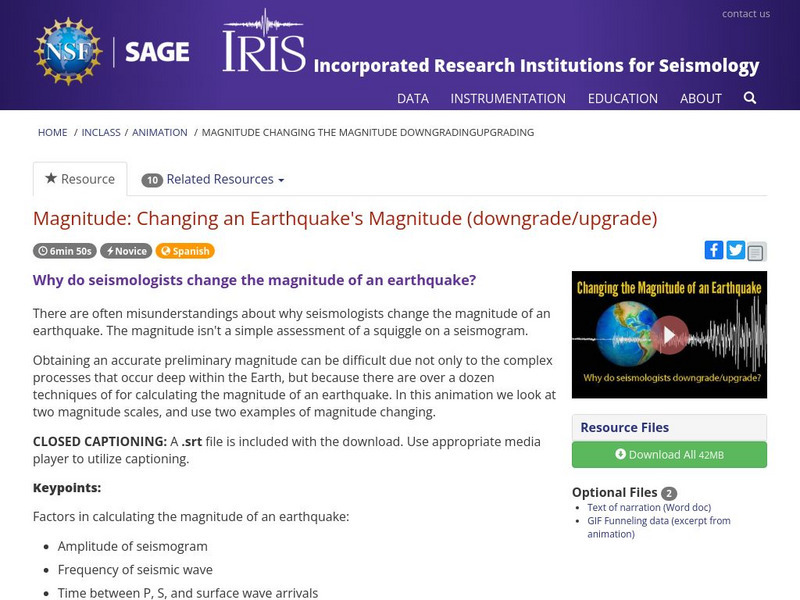Curated Video
S-wave
One of two types of seismic wave produced in an earthquake. A Twig Science Glossary Film. Key scientific terms defined in just 60 seconds using stunning images and concise textual definitions. Twig Science Glossary Films reinforce...
Curated Video
Seismic waves
Sound-like waves that travel through the ground from an earthquake or other source of vibration. A Twig Science Glossary Film. Key scientific terms defined in just 60 seconds using stunning images and concise textual definitions. Twig...
Curated Video
P-wave
A fast-moving seismic wave produced by an earthquake. A Twig Science Glossary Film. Key scientific terms defined in just 60 seconds using stunning images and concise textual definitions. Twig Science Glossary Films reinforce abstract...
Curated Video
Shake Things Up
Dr. Forrester demystifies earthquakes. She explains how they are created.
Curated Video
Wave Speed, Wavelength, and Frequency: Understanding their Relationship
This video is a lecture that explains the relationships between wave speed, wavelength, and frequency of a wave. It starts by defining a transverse wave and discussing the amplitude, wavelength, frequency, and time period of a wave. The...
Visual Learning Systems
Understanding Seismology
The video explains the three main types of seismic waves that are produced when rocks move and crumble during an earthquake: primary waves, secondary waves, and surface waves. Volcanoes and Earthquakes part 10/13
Next Animation Studio
Geologists claim iron snow is falling on Earth’s core
It is snowing iron at the Earth’s core because molten iron crystallizes in the outer core before the substance sinks downwards.
Curated Video
People watching for seismic activity at HK observatory; Hang Seng Index
1. Pan across exterior of Hong Kong Observatory
2. Sign on exterior of Hong Kong Observatory
3. Man working at computer monitors
4. Close up of computer screen showing seismic data
5. Mid shot of computer screens showing seismic data
6....
Scholastic
Study Jams! Earthquakes
Have a seismic moment with your class as you show this animated video on earthquakes. Viewers find that quakes occur on faults and are caused by shifting of continental plates. They learn what properties are studied by seismologists and...
US Geological Survey
U.s. Geological Survey: Earthquakes: Wavefront
A quick animation of the instantaneous boundary between seismic waves inside the earth.
Khan Academy
Khan Academy: Seismic Waves and How We Know Earth's Structure
This video illustrates and explains how seismic waves function. These waves are broken down into two types: surface and body. Take a look into why waves help understand the structure of Earth. [8:38]
Incorporated Research Institutions for Seismology
Iris: Us Array Visualizations: Tutorial on Viewing
An introduction to understanding what USArray visualizations provide. Earthquake waves are captured and turned into a graphic video. [2:24]
Incorporated Research Institutions for Seismology
Iris: Seismic Wave Behavior: A Single Boundary Refracts & Reflects
This introduction to seismic wave behavior describes Snell's Law and how it applies to layers in the earth. It addresses reflected, refracted, critically refracted, and head waves. Seismic waves travel at different speeds through...
US Geological Survey
U.s. Geological Survey: Earthquakes: Directivity
A quick animation showing directivity, the directional movement of the seismic energy between two stations.
US Geological Survey
U.s. Geological Survey: Earthquakes: Shadow Zone
An animation showing the area of the Earth that is not detectable by seismographs, known as the shadow zone.
Incorporated Research Institutions for Seismology
Iris: Travel Time Curves: How They Are Created
An animation which illustrates how the travel time of an earthquake is measured. What alters the velocity of the waves? [1:06]
Incorporated Research Institutions for Seismology
Iris: Seismic Wave Behavior: Critically Refracted Rays Ping Arrivals
A brief video will illustrate how a ping announces refracted seismic waves. [0:34]
Incorporated Research Institutions for Seismology
Iris: Magnitude: Changing an Earthquake's Magnitude (Downgrade/upgrade)
In this animation take a look at two magnitude scales, and use two examples of magnitude changing. [6:54]
US Geological Survey
Usgs: Earthquakes: Attenuation
An animation featuring the attenuation of seismic waves as they move farther away from the source.







